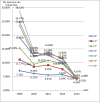Blood lead levels in children aged 0-6 years old in Hunan Province, China from 2009-2013
- PMID: 25830596
- PMCID: PMC4382167
- DOI: 10.1371/journal.pone.0122710
Blood lead levels in children aged 0-6 years old in Hunan Province, China from 2009-2013
Abstract
Objectives: The aim of this study is to describe blood lead levels (BLLs) and the prevalence of elevated blood lead levels (EBLLs) in children aged 0-6 years old and to analyze the BLL trend in children from 2009 to 2013 in China.
Methods: A total of 124,376 children aged 0-6 years old were recruited for this study from January 1st 2009 to December 31st 2013. Their blood lead levels were analyzed using atomic absorption spectrometry.
Results: The median BLL was 64.3 μg/L (IQR: 49.6-81.0), and the range was 4.3-799.0 μg/L. Blood lead levels were significantly higher in boys (66.0 μg/L) than in girls (61.9 μg/L) (P<0.001). The overall prevalence of BLLs≥100 μg/L was 10.54% in children aged 0-6 years in Hunan Province. Between 2009 and 2013, the prevalence of EBLLs (≥100 μg/L) decreased from 18.31% to 4.26% in children aged 0-6 years and increased with age. The prevalence of EBLLs has dramatically decreased in two stages (2009-2010 and 2012-2013), with a slight fluctuation in 2010 and 2011.
Conclusions: Both BLLs and the prevalence of EBLLs in children aged 0-6 years old declined substantially from 2009 to 2013 in Hunan Province; however, both remain at unacceptably high levels compared to developed countries. Comprehensive strategies are required to further reduce blood lead levels in children.
Conflict of interest statement
Figures
Similar articles
-
The national trend of blood lead levels among Chinese children aged 0-18 years old, 1990-2012.Environ Int. 2014 Oct;71:109-17. doi: 10.1016/j.envint.2014.06.005. Epub 2014 Jul 9. Environ Int. 2014. PMID: 25000556 Review.
-
[An epidemiologic survey on blood lead levels in preschool children living in towns of Hunan Province].Zhongguo Dang Dai Er Ke Za Zhi. 2010 Aug;12(8):645-9. Zhongguo Dang Dai Er Ke Za Zhi. 2010. PMID: 20704800 Chinese.
-
Blood lead levels in children, China.Environ Res. 2006 Jul;101(3):412-8. doi: 10.1016/j.envres.2005.11.007. Epub 2006 Jan 25. Environ Res. 2006. PMID: 16442092 Review.
-
Surveillance of childhood blood lead levels in 11 cities of China.World J Pediatr. 2014 Feb;10(1):29-37. doi: 10.1007/s12519-014-0452-6. Epub 2014 Jan 25. World J Pediatr. 2014. PMID: 24464661
-
Screening for childhood lead poisoning in the industrial region of Fez, Morocco.Arch Environ Contam Toxicol. 2015 Apr;68(3):442-50. doi: 10.1007/s00244-014-0108-5. Epub 2014 Dec 16. Arch Environ Contam Toxicol. 2015. PMID: 25511562
Cited by
-
High blood levels of lead in children aged 6-36 months in Kathmandu Valley, Nepal: A cross-sectional study of associated factors.PLoS One. 2017 Jun 12;12(6):e0179233. doi: 10.1371/journal.pone.0179233. eCollection 2017. PLoS One. 2017. PMID: 28604801 Free PMC article.
-
Evaluation of Essential and Toxic Elements in the Blood of 0-14-Year-Old Children in Hunan, China From 2013 to 2019: A Retrospective Analysis.Front Public Health. 2022 Apr 18;10:739880. doi: 10.3389/fpubh.2022.739880. eCollection 2022. Front Public Health. 2022. PMID: 35509513 Free PMC article.
-
Blood Lead Level in a Paediatric Population of South-Eastern Spain and Associated Risk Factors.Int J Environ Res Public Health. 2021 Feb 13;18(4):1825. doi: 10.3390/ijerph18041825. Int J Environ Res Public Health. 2021. PMID: 33668485 Free PMC article.
-
Blood Lead Levels and Risk Factors among Preschool Children in a Lead Polluted Area in Taizhou, China.Biomed Res Int. 2017;2017:4934198. doi: 10.1155/2017/4934198. Epub 2017 Mar 29. Biomed Res Int. 2017. PMID: 28466011 Free PMC article.
-
Prevalence and risk factors of elevated blood lead levels in 0-6-year-old children: a national cross-sectional study in China.Front Public Health. 2025 Mar 26;13:1546842. doi: 10.3389/fpubh.2025.1546842. eCollection 2025. Front Public Health. 2025. PMID: 40206156 Free PMC article.
References
-
- Rogan WJ, Ware JH. Intellectual impairment in children with blood lead concentrations below 10 microg per deciliter. J Pediatr. 2003;143(5):687–8. - PubMed
-
- Glenn BS, Bandeen-Roche K, Lee BK, Weaver VM, Todd AC, Schwartz BS. Changes in systolic blood pressure associated with lead in blood and bone. Epidemiology. 2006;17(5):538–44. - PubMed
Publication types
MeSH terms
Substances
LinkOut - more resources
Full Text Sources
Other Literature Sources
Medical




